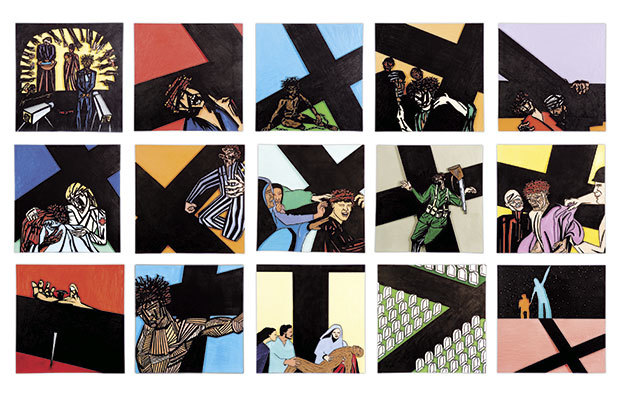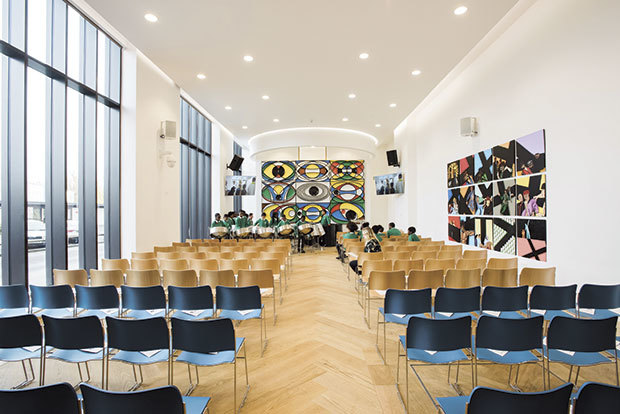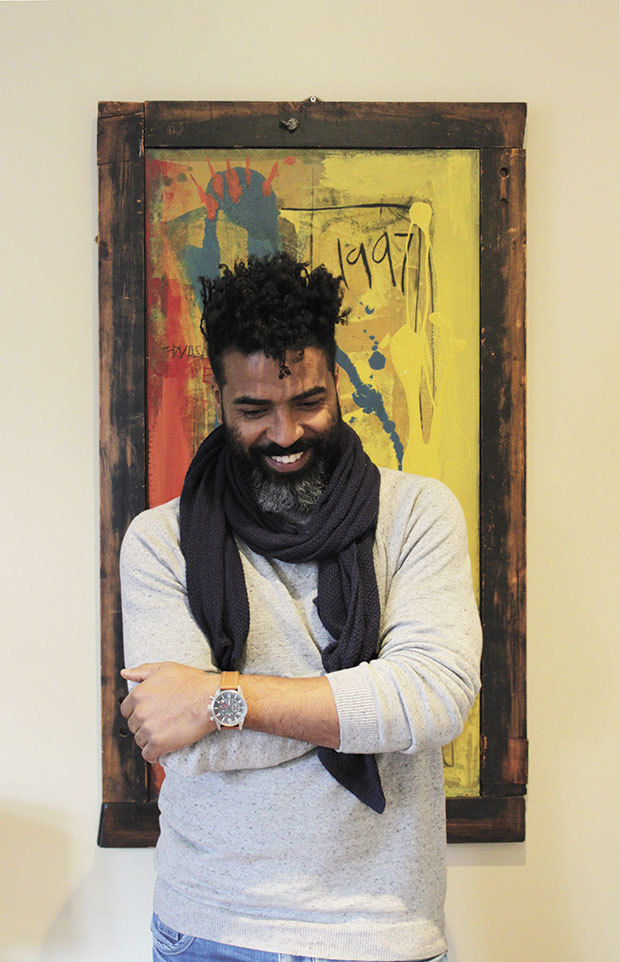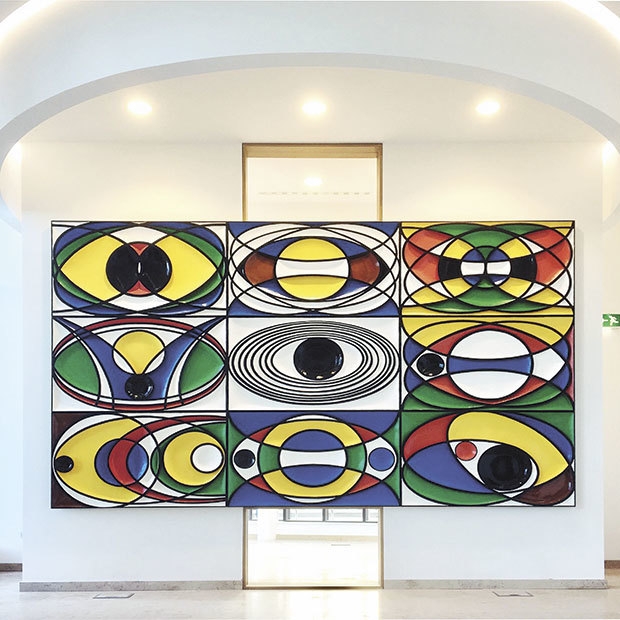From hip-hop and rasta to the Christian altar-piece
Graeme Mortimer Evelyn – a practicing Buddhist, former Rastafarian and percussionist for santeria trance ceremonies – has just finished a resplendent altar piece for a Christian church in Tottenham Hale, a working-class suburb of north-east London. The largest contemporary altar-piece in Europe, a strange and surprising combination indeed. And yet, if you dive into Evelyn’s roots and the story of his evolution as an artist, it makes total sense, as if destiny had played a crucial part in the creation of this very striking and original piece of contemporary religious art.
Von Mark Kidel
In The Stations of the Cross, Evelyn, a practicing Buddhist, aimed for a series of images that would speak to atheists as well as Christians. In the rhythmically structured panels, the image of the cross is never whole, but provides a series of bold lines that pull the narrative together in a powerfully graphic way – Evelyn’s background as a young graffiti artist strongly present. He presents people of many colours and cultural backgrounds, a soldier as well as a Jewish prisoner in a Nazi camp. Jesus himself is neither white nor black. The final panel, which evokes the resurrection – a station of the cross Evelyn added as he felt the New Testament story should not end with sacrifice and death. In it two figures look up at a starlit emptiness. He was inspired by the story told by the survivor of a mass killing in Eastern Europe, as thousands of naked Jews were being machine-gunned, at night, at the edge of a pit they had been forced to dig. Along with whole families huddled together in terror, a grandmother rocking a crying baby, there was a father comforting his frightened son: “ Fear not, my son”, he said, pointing at the stars in the vast night sky, “that is you up there, you will be alright”.
Evelyn’s parents came to Britain from Jamaica. They settled in the grim city of Luton, famous above all for its budget-flight airport and the Arndale shopping mall, a monument to brutalist architecture. The parents did well and ran a mobile catering company. Grame Mortimer was born 1969. As a boy, Evelyn did break-dancing, DJ’ed and spray painted graffiti inspired by comic books all over the walls of his hometown. He wanted to do art, but his parents steered him towards business. He studied marketing, but soon responded to the passion burning inside him: he went to the Anglia Ruskin School of Art in Cambridge. “That marketing stuff” he says,” has stayed with me, and helped a great deal. I understand about making images speak and the need to get people’s attention”.

Evelyns Beginn sakraler Auftragsarbeiten für die gotische Kathedrale in Gloucester, 2006. Bemalte MDF-Reliefskulpturen. Künstler Graeme Mortimer Evelyn interpretierte die Passion Christi neu und ergänzte um eine Station: die Wiederau- ferstehung. Die Verurteilung Christi erfolgt heute mit Live-Übertragung am TV-Bildschirm (1. Bild links oben), der KZ-Insasse (2. Bildreihe, 2. Bild v.l.) und der getötete Soldat (2. Bildreihe, 2. Bild v.r.) verweisen in dieser modernen Interpreta- tion des Kreuzwegs auf die Leitthemen Sklaverei, Genozid und Krieg. / Abbildung: © Graeme Mortimer Evelyn
In The Stations of the Cross, Evelyn, a practicing Buddhist, aimed for a series of images that would speak to atheist as well as Christians. In the rhythmically structured panels, the image of the cross is never whole, but provides a series of bold lines that pull the narrative together in a powerfully graphic way – Evelyn’s background as a young graffiti artist strongly present. He presents people of many colours and cultural backgrounds, a soldier as well as a Jewish prisoner in a Nazi camp. Jesus himself is neither white nor black. The final panel, which evokes the resurrection – a station of the cross Evelyn added as he felt the New Testament story should not end with sacrifice and death. In it two figures look up at a starlit emptiness. He was inspired by the story told by the survivor of a mass killing in Eastern Europe, as thousands of naked Jews were being machine-gunned, at night, at the edge of a pit they had been forced to dig. Along with whole families huddled together in terror, a grandmother rocking a crying baby, there was a father comforting his frightened son: “ Fear not, my son”, he said, pointing at the stars in the vast night sky, “that is you up there, you will be alright”.
As a student he made woodcut prints, all of them in black and white. His influences ranged from the comics of his youth and pop art to German Expressionism, particularly the work of Karl Schmidt-Rottluff. He was, he says, “scared of colour”. Looking back, it may have been an instinctive knowledge of the overwhelming power of pigment, as well as the discovery of his own synesthesia – the ability to link music, colour and form – that kept him from plunging too deep too fast.
He was drawn to Rastafarianism, the Caribbean-based religious community. This introduced him to drumming and ritual, both of which have been essential elements in his life, as well as influences on his art. He went on to study the percussion of Cuba, Puerto Rico, Brasil and Trinidad, which were connected to a wealth of visual references as well as strong story-telling traditions, all of them rich with moral and spiritual resonance.
Later he travelled to India – an experience that led to further change and the deepening of his spiritual understanding – and onto Nepal. He spent time meditating but also studying textile printing and block-carving techniques. “These cultures pushed colour into me” he recalls, “everything started to change.”
The various religious communities he encountered, often taking part in ceremonies and rituals as a percussionist, taught him about the connections between music, art and spiritual practice, as well as the importance of communal ‘spaces’ accessible to all: a contrast with the exclusive art museums and galleries, where those who dare enter are expected to understand ‘artspeak’. He wanted to work outside these “elitist temples”, and felt as well a need to subvert traditional places of worship and prayer.

Foto: © Diocese of London
A decisive moment occurred, when he was invited to create work for Gloucester Cathedral, an impressive Gothic building in the West of England. The Dean was open-minded and accepted that the artist was a practicing Buddhist, not a Christian. Evelyn made a series of paintings on MDF board, very loose but contemporary interpretations of the Stations of the Cross that captured something essential about the meaning of each of them. His time as a Rastafarian, taking part in vodun and santeria trance rituals, meditation, hip-hop and break-dancing, all of them went into it. Feeling that Christianity places too much emphasis on the suffering and crucifixion of Christ, he added a final Station, the moment of resurrection. He had learned through his own experience that rebirth is constant, when you live your live fully in the present. The work was very popular: Evelyn was told that people visiting the cathedral were moved to tears, and the Dean used the paintings to teach visitors and worshippers about the deeper meaning behind the Stations.
The work in Gloucester led to other commissions, culminating in the new sanctuary in Hale Village and the commission of a hand-carved and painted altar piece, The Eternal Engine, the largest contemporary work of its kind in Europe. This is rough part of London: the mainly black population rioted here not so long ago, but the local authorities have done their best to build new estates – low-rise and human-scaled. Evelyn lived for a year in Hale, and has worked closely with the local community. It is the first church to have been built in England in the last 40 years. Graeme Evelyn was asked to evoke the divine –specifically in terms of the idea of Creator, Redeemer and Sustainer, the new Anglican terms for the traditional trinity of Father, Son and Holy Ghost. In the altar-piece, Evelyn avoided being illustrative literal, and went for images that would, he hoped, touch people directly.

Graeme Mortimer Evelyn, geb. 1969 im englischen Luton, ist Musiker, DJ und bildender Künstler. Nach der Serie Passion Christi für die Kathedrale Gloucester wurde er mit einem Altarbild für die Anglikanische Kirche St. Francis und The Engine Room in London beauftragt. Es ist das bislang größte zeitgenössische Altarbild Europas. / Foto: © Courtesy of Artist
Evelyn worked, as he always does, with music: he drew inspiration from the cycles of astronomy – the sun, galaxies and black holes. The former break-dancer and hip-hop DJ feels that the colours and shapes in the final work, “help it to dance” and draw in the person before it, stimulating reflection and religious experience. For Evelyn, who follows a Buddhist tradition in which meditation is done with eyes wide open, the act of looking creates a bridge between inner and outer worlds, bringing them together in wholeness and unity.
He was also asked to make other work for what will become a centre for meditation and spiritual practice, an integral part of a multi-purpose building, a keystone of Tottenham Hale’s attractive new estate.
www.graemevelyn.com
https://open.spotify.com/user/11122481069

